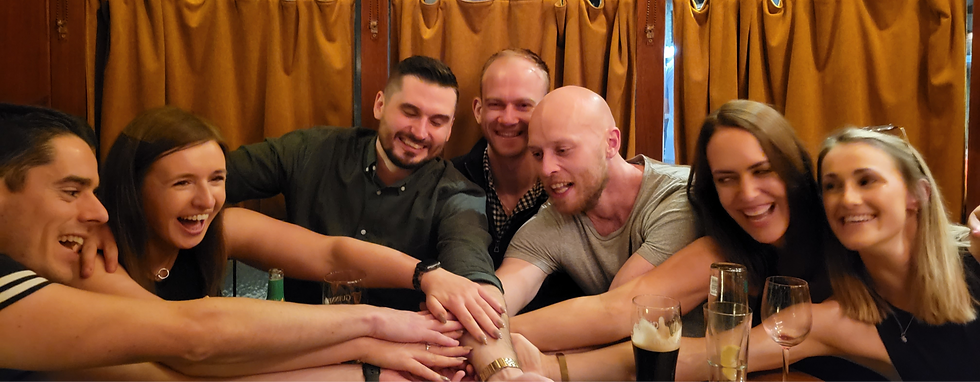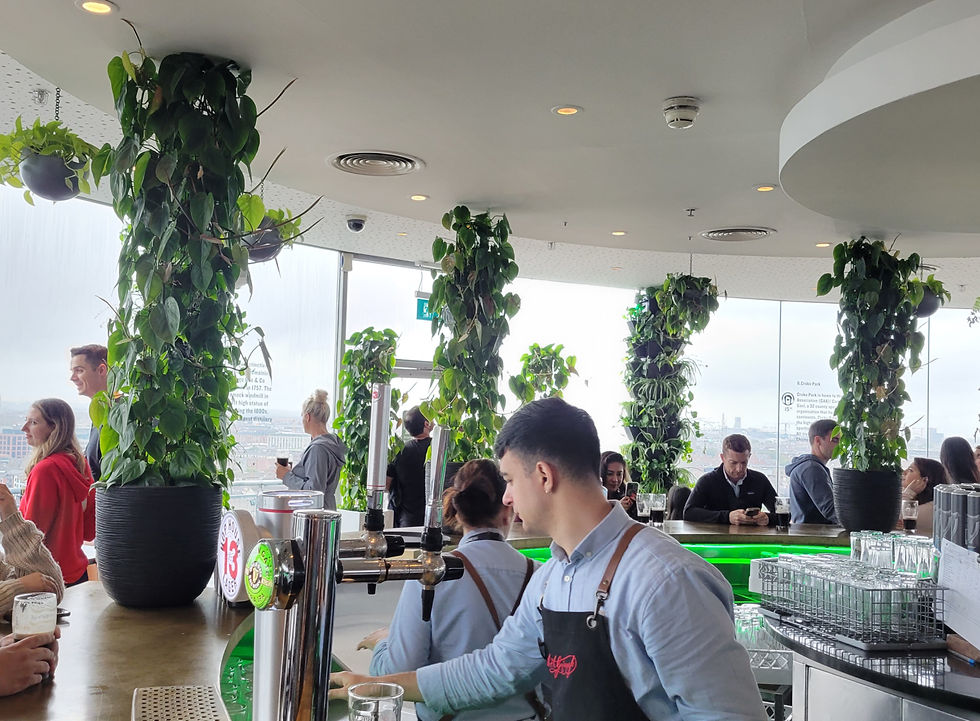Tips for a Terrific First Trip to Ireland
- Kathie
- Sep 8, 2024
- 8 min read
Ireland is a country brimming with charm, breathtaking landscapes, and rich culture. If you’re looking for stunning landscapes, Ireland’s rugged cliffs of the Wild Atlantic Way and the serene lakes of Killarney National Park will delight your senses.
Ireland’s rich history is equally captivating. With ancient castles, monastic ruins, and prehistoric sites like Newgrange and Clonmacnoise, there’s a story around every corner. From the Viking influence in cities like Dublin and Waterford to the profound legacy of Celtic culture, the country offers countless opportunities to dive into its fascinating past.
The friendly Irish people are known for their warm hospitality and genuine kindness, often going out of their way to help visitors feel welcome. If you're planning your first trip, here are some essential tips to make the most of your experience.
Be Prepared for Every Season

The Irish weather is famously unpredictable. You might experience rain, sun, wind, clouds and rainbows all in the same day! Be sure to pack layers and a good waterproof (not just water resistant) rain jacket. I do take an umbrella with me but I haven’t used one in years. The last time I did, the wind turned it inside out and I was worried about flying away like the Nannys in Mary Poppins.
When I’m out sightseeing, I wear waterproof pants, waterproof hiking shoes and a good rain coat, plus I have a rain cover for my backpack. The weather won't stop your adventures if you're properly prepared, so it’s good to be ready for rain and wind! See my blog about Be Prepared.
But remember, in Ireland when the sun comes out, be sure to look for the rainbow.
Why You Should Visit a Pub in Ireland

Ireland’s pub culture is legendary, offering much more than a place to grab a pint. My mom, after looking at pictures of my trips to Ireland, asked me why I spent so much time in bars. So I had to take her to Ireland to show her that Irish pubs are not just bars. They are social hubs where locals gather to chat, listen to live music, enjoy hearty meals and join in on lively conversations.

While you’re in Ireland, make sure you experience both the big city pubs in Dublin or Belfast, and the smaller, more rural ones which often have local musicians playing traditional music, called a “trad session” or Session for short (seisiún in Irish Gaelic). See the video below.
A Session is usually an informal gathering of several musicians seated in a corner lead by a fiddle or guitar and accompanied by any or all of the following: penny whistle, flute, banjo, accordion, bodhran (hand drum) and other instruments even spoons, washboards and saxophones.
One time, our son was able to sit in on a session with his saxophone.

Pub Etiquette in Ireland
There are some rules of etiquette that are good to know before you venture into an Irish pub:
Ordering and Paying - When you first walk into an Irish pub, there is no waitress stand or signs telling you what to do. You need to walk up to the bar and survey the beers on draft, and the bottles of Irish Whiskey and other liquor behind the bar. They typically also serve wine and cocktails, especially gin drinks, which have become very popular, along with soft drinks, coffee, and tea. So don’t be afraid to ask, if you don’t see something that you want to order.
You will pay at the bar, and you typically pay per drink/order with either cash or card. No tips are required or expected when you pay at the bar.
Rounds - If there are no open tables but there are open seats at a table, you can ask the people sitting there if they mind if you join them. It can be intimidating at first, but will often end up being great fun, and you'll make new friends. When someone gets up to go get themselves a drink, they will often asked, “Buy you a round?” It’s fine to answer yes, but just realize you will then be expected to also buy a round.

Note: Watch out for over-indulging. If you’ve already had one drink, then they buy the next round, then when you buy the next round, you’ll be on drink number three. It’s easy to lose track of how much you’re drinking when you’re not paying for every drink. And if you have to be on the road the next morning, it can be painful!
No “Car Bombs” or “Black and Tans”- Just a word of caution so you won’t be unintentionally insulting. In the US in Irish Pubs, you may have ordered a Car Bomb (Guinness with a dram of Bailey’s dropped in it) or a Black and Tan (Bass & Guinness), but do not ask for these in a pub in Ireland. The bar man, after giving you a freezing look, will ask you if you’d prefer something like a Twin Towers Torpedo.
Lock-ins - These are a rare treat! Don’t be scared, if after last-call in an Irish pub, the publican starts closing the blinds and locking the door (with you inside) to keep new people from coming in. In theory, the pub is now a private property or a party, and they can continue serving but will expect you to pay in cash. (More about tipping and cash below.)
But don’t forget, it is all about fun. The idea is to enjoy the "craic" when you’re visiting an Irish pub.
What is Craic and How to Enjoy It

The Irish term "craic" (pronounced "crack") epitomizes Ireland’s social culture. It refers to fun, good times, and lively conversation. You’ll hear people asking, “What’s the craic?” to see how you are. Don’t miss out. Join in on the craic. Talk to the person next to you in a pub, listen to live traditional music, and embrace the laid-back, friendly Irish atmosphere. Whether it’s enjoying foot-stomping pub music or laughing over a pint, craic is all about having a fun time.
To Kiss (or Not Kiss) the Blarney Stone
Speaking of fun, visiting Blarney Castle and kissing the famous Blarney Stone is a classic tourist activity in Ireland. You might be like me and a definite NO for putting your lips where thousands of other's have, but it was great fun watching our travel companions do it, and the views from the top of the roofless castle are worth the climb, and the gardens are gorgeous!
Legend says that kissing the stone will grant you the gift of eloquence. I may do it the next time - who can’t use some eloquence?!
The kissing stone itself is located high inside the castle, and you have to lean backward while lying down to give it a smooch. But there are railings to hold on to and a nice gentleman there to help you lean back and then get back up.
Note: The stairs on the way up are exposed so it’s good to have non-slip shoes. See my blog about Be Prepared.
What is the Difference Between the Republic of Ireland and Northern Ireland?

Ireland Map Source: Nations Online Project
Ireland is divided into two distinct regions: the Republic of Ireland and Northern Ireland. The Republic of Ireland is an independent country (thanks to Michael Collins - look up the movie of the same name), while Northern Ireland is part of the United Kingdom, but both are proud to be part of the Island of Ireland.
The Republic of Ireland, like most of Europe, uses the Euro (€) as its currency, while Northern Ireland (like England, Scotland and Wales) uses the British Pound (£). For more information see my blog about Money & Credit Cards.
When planning a trip, remember that while you’ll pass through an invisible border, there are differences in road signs (including speed limits), currency, and even emergency numbers between the two. (If you’re driving in Ireland, that’s an entire blog subject on it’s own, which I’ll be covering soon.)
The most common sites you’ve probably heard of in Northern Ireland are the scenic Giant’s Causeway, which is a UNESCO World Heritage site, and Carrick-a-Rede Rope Bridge (but just note that tour buses can no longer park at the bridge). Other popular Northern Ireland destinations include the Dark Hedges (featured in Game of Thrones) and the vibrant city of Belfast with the Titanic Exhibit and the Glens of Antrim just north of Belfast.
The Cliffs of Moher: By Land or Sea
The Cliffs of Moher are one of Ireland's most iconic landmarks, towering over the Atlantic Ocean and there are multiple ways to see them.
You can explore these majestic cliffs by foot, enjoying the panoramic views of the rugged coastline either by walking up past the Visitor’s Centre or by walking along the coast itself. Alternatively, you can take a boat tour from Doolin and see the cliffs from the sea, where you'll gain a whole new perspective on their vastness.
The boats are of course dependant on the weather, so it is a good idea to plan on both options.
Money Tips
Most places in Ireland accept Visa and Mastercard, though it's always useful to have some cash on hand for smaller purchases (including toilets and tipping - see below). You can tap your card for some purchases or you may have to insert the chip. If neither work, they should be able to slide your card.
To get cash, it is recommended to just use an ATM when you're in Ireland. I recommend using an ATM at a bank and avoid the ones that are at the back of a convenience store. If you’re more comfortable taking cash with you, then it’s possible to get money from your bank. Or you can exchange dollars for Euros (or Pounds) at the airport or at a bank in Ireland, but you’ll pay more. See my blog about Money & Credit Cards.
Tourists may be eligible for a VAT (Value Added Tax) refund on purchases in the Republic of Ireland. (The UK did away with VAT refunds after Brexit.) You either have to keep your receipts or get a Fexco Horizon Card (which is not accepted everywhere). The easiest thing to do is purchase most of your souvenirs at one place, like the Woolen Store at Blarney castle, so you have fewer receipts to deal with.
If you’re planning on visiting 4 or more of the Republic of Ireland’s castles, heritage sites and monuments, consider investing in a Heritage Card. See this page for the Heritage Card’s list of sites.
Tipping in Ireland

Tipping in Ireland isn’t as formal as in other countries. In pubs, it’s not necessary to tip for drinks at the bar. However, in restaurants, if you receive table service, leaving a tip of about 10-15% is customary. If you're unsure, just round up the bill, for example giving €15 instead of €14.20 in cash (but you cannot tip with a credit card). Tipping in hotels or taxis is also appreciated but not required. For more detail, see my Blog About Tipping.
Best 2 Days in Dublin
If you only have a few days in Dublin, make the most of it by visiting some of the city’s top attractions.
Day 1: Start with a tour of Trinity College and the stunning Book of Kells. While you’re in the neighborhood, pop over to the Irish Whiskey Museum for a fun tour. Next, walk to the O’Connell Street bridge over the River Liffy and see:
the GPO – the General Post Office which was the headquarters of the 1916 Easter Rising,
the Ha’Penny Bridge, a picturesque and iconic pedestrian bridge, and
the statue of Molly Malone, celebrated in the famous Irish song "Cockles and Mussels."
Then finish the day with dinner and a walk through the well-lit Temple Bar district.
For more detail, see Dublin - My Top 10 Things To Do blog.
Day 2: Begin the day with Dublin Castle and Christchurch Cathedral. Then take a stroll down Grafton Street, the famous pedestrian shopping area. Next, take a peaceful walk in St. Stephen’s Green. Since 1880, the citizens of Dublin have used this green space to walk, sit on a bench or lie on the grass and enjoy a moment of sunshine. Its Victorian layout, with extensive tree and shrub plantings, provides vibrant color from early spring to late autumn.
In the afternoon, visit the Guinness Storehouse for a fascinating tour. At the end, you can enjoy a pint at the Gravity Bar with a panoramic view from the 7th floor of the circular building, with floor to ceiling 360 degree views.

Extra Days: If you have more time, consider day trips to the Boyne Valley and Newgrange passage tomb and the Hill of Tara, Trim Castle, or Ancient East city of Kilkenny and the beauty and tranquility of the lakes and glacial-carved valley of Glendalough.
See my blog about Day Trips from Dublin.
Ireland offers endless opportunities for fun, adventure, discovery, and relaxation. Whether it’s enjoying a pint in a lively pub, exploring ancient castles, or standing awe-swept looking over the Cliffs of Moher, Ireland has something for everyone.
Contact me to help you with your next trip.


























Comments